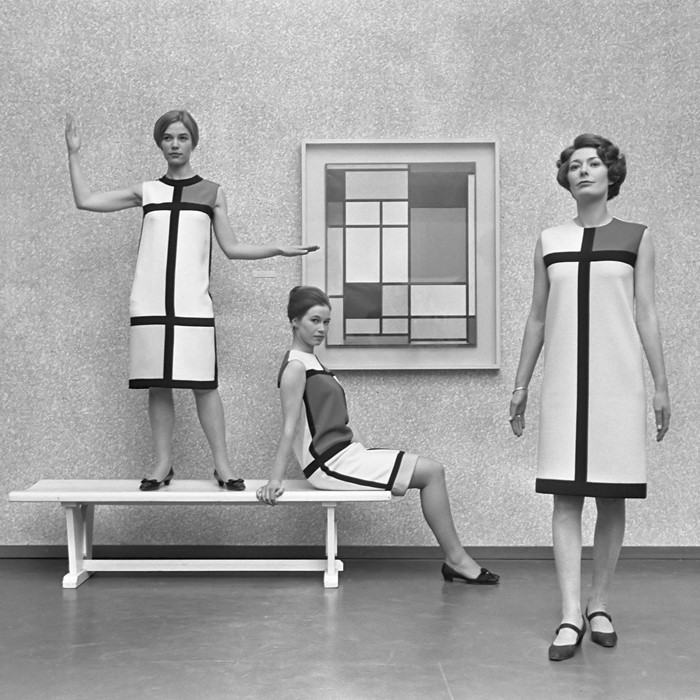
Saint Laurent & Mondrian
When Yves Saint Laurent died in 2008 his entire art collection, comprising of 1,200 pieces, was sold for nearly 375 million euros. He had always had a passion for art, expressing his admiration by not only amassing an impressive collection, with his partner Pierre Bergé, but also allowing the artists he admired the most to heavily influence his designs. Over the years Saint Laurent’s collections featured many looks inspired by great works of art. Undoubtedly though, the most notorious of all were the six shift dresses he debuted in his 1965 Autumn Couture Collection, inspired by Composition II with Red, Blue and Yellow, the instantly recognisable painting by Dutch painter Piet Mondrian.
Although often referred to as the ‘Mondrian Collection’, the show actually featured many other artists’ influences, and the Mondrian references only counted for six out of the total eighty looks. Other notable inspirations for this collection came from French painter Serge Poliakoff and Russian formalist, Kazimir Malevich. But, in spite of this it is the Mondrian dresses that demanded the attention of the crowd then and continue to do so now. Saint Laurent saw the popular shift style as the perfect canvas to transform Mondrian’s painting into walking works of art. This particular style of dress was hugely popular during the sixties, a modern take on its predecessor the sack dress. The red, yellow, and blue wool inlays cover the garment without a single seam appearing on show, an extraordinary feat of design and a real testament to how committed Saint Laurent was to keeping the design as accurate as possible. The jet black lines that divide the vivd blocks of primary colours are sharp and straight and really capture Mondrian’s intricate precision. The dresses were worn with single buckled pilgrim shoes designed by Saint Laurent’s longtime collaborator Roger Vivier. These shoes went on to become stars in their own right, thanks to Catherine Deneuve, whose character in the classic French film, Belle du Jour, famously wore them with a patent trench coat.
The international press were enthralled by the collection, Diana Vreeland unequivocally celebrated the show in the New York Times calling this “the best collection”, Women’s Wear Daily hailed Saint Laurent the “King of Paris” and Harper’s Bazaar saw the future of fashion in the Mondrian dresses, quoting: “this is the dress of tomorrow – the assertive abstraction, a semaphore flag, perfectly proportioned to flatter your figure”.
The success of this show could not have come at a better time for Saint Laurent. His previous show, earlier in the year had received little to no praise from critics, and he was evidently beginning to struggle to keep up with the continuously changing mood of the fashion industry. On the day of the show, Saint Laurent declared that “everything is new, this collection is young, young, young.” He later said that “Mondrian was my last minute inspiration. Nothing was alive, nothing was modern in my mind except an evening gown I had embroidered with palettes like a Poliakoff painting. It wasn’t until I opened a Mondrian book my mother had given me for Christmas that I hit the on the key idea.”
After the show the popularity of the dress showed no signs of wavering, reaching a whole new level of stardom when English model Moyra Swan wore it on the cover of Vogue Paris for the September 1965 issue. Shot by David Bailey, Swan wore the dress with the matching Vivier shoes and sported an iconic Vidal Sassoon bob haircut that had become synonymous with the era. Slanted across the cover she effortlessly epitomised everything the swinging sixties was about. In the same year Jean Shrimpton appeared wearing the dress in a shoot by Richard Avedon for Harper’s Bazaar, after some time the dress had been seen on everyone in every magazine and Shrimpton herself declared it ‘boringly popular”.
Yves Saint Laurent greatly admired Mondrian’s work, and cherished the purity he observed in Mondrian’s distinctly unadorned style, and although there’s no denying that the inspired dresses were effortlessly beautiful, his decision to commercialise the classic painting sat at odds with what Mondrian hoped his work would do for the world. Piet Mondrian believed that his art could help people free themselves from their ever growing dependence on disposable material objects. He lived a lot of his life as somewhat of an outsider, owning very few possessions. He was fascinated by the notion of spiritual laws and believed that certain higher rhythms were being interrupted by the commercial greed and endless political conflict that the world found itself in. With Mondrian’s ethos in mind, it seems unlikely that he would have approved of Saint Laurent’s use of his design in this way, but the success of the Mondrian Dress is undeniable.
Yves Saint Laurent went on to produce more collections inspired by his most revered artists following the critical acclaim of this collection, it became a vital part of his success and played a pivotal part in why his legacy still endures to this day.
